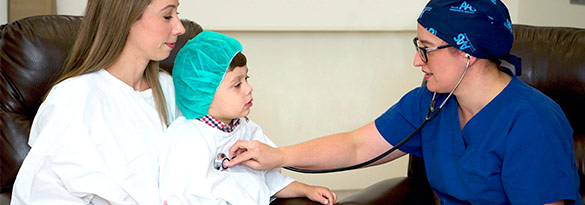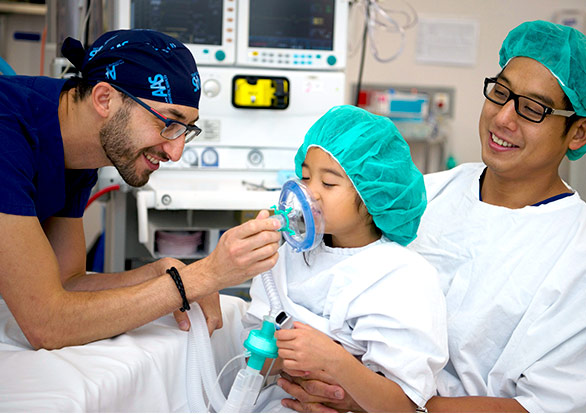ABOUT ANAESTHESIA
Anaesthesia for Children
Surgery for your child can be as stressful for you as it is for them.
While these experiences can feel overwhelming, you can trust good anaesthetic care to make things easier for you. Our anaesthetists are trained to ensure your child’s surgery is as safe and stress free as possible, for both of you.
Types of Anaesthesia
Anaesthesia can be broken down into three main categories; general, regional and local. Depending on your child’s procedure, the anaesthetist will determine which method of induction is the most appropriate to administer the anaesthetic. Your child may have intravenous anaesthesia, where we place a small needle in a vein and inject a sedative drug. Alternatively, they may breathe anaesthetic gas. The gas can take a few minutes to have effect and has a pungent smell.
General anaesthesia
General anaesthesia keeps your child completely unconscious throughout their procedure. The anaesthetist will be present from beginning to end to closely monitor your child. After the procedure is complete, the anaesthetist reverses the process and ‘wakes up’ your child, with recovery usually taking around 45 minutes to an hour.


Regional and local anaesthesia
Regional anaesthesia is a way of blocking painful sensations from a limb or part of the body during and after surgery with local anaesthetic. To produce pain relief to a specific area, the skin around the area being operated on is infiltrated with local anaesthetic or specific nerves supplying that area are blocked. There are a large number of techniques of local and regional anaesthesia we can use, allowing most parts of the body to be successfully numbed.
In children, local anaesthetic is injected after the children are sedated or anaesthetised so they’re unaware of the injection. Your anaesthetist will discuss regional anaesthesia with you if it is appropriate in your child’s situation.
What to expect from your anaesthetist
The preoperative examination is your opportunity to ask any questions and give your anaesthetist as much information as possible! Your anaesthetist will want to know about:
- When your child last had anything to eat or drink
- Any recent coughs or colds and fevers
- Any previous anaesthetics or family problems with anaesthetics
- Abnormal reactions to drugs or allergies
- Any history of asthma, bronchitis, heart problems or other medical problems
- Whether your child is on any medication at present
- Any loose teeth
A “pre-med” is any medication given to your child prior to the operation. Before surgery, we commonly administer painkillers such as Panadol or Nurofen or sedatives to help your child relax or fall asleep.
Sometimes an anaesthetic cream may applied to the back of your child’s hand and a plastic dressing applied as a cover. This cream slowly penetrates the skin and numbs the area. After 60 minutes, the skin is anaesthetised and the pain associated with needles is significantly reduced. Some children can get a mild reaction to the cream or dressing with some redness.
We often allow one parent to accompany your child during the anaesthetic induction process. However, if you are very nervous or upset, it’s usually best not to come into the anaesthetic room. Your child will pick up on your anxiety which will make the anaesthesia process more difficult for them.
In some circumstances, you may not be allowed to accompany your child. Remember, our primary concern is keeping your child safe, so you must agree to leave when you’re not feeling well, when we ask you to leave and/or when your child is asleep.
It’s common for parents to feel distressed when their child is anaesthetised. With intravenous anaesthesia, your child may become unconscious rapidly and look pale and limp. Gaseous anaesthesia can sometimes upset small children. It’s natural to get a little teary! Your anaesthetist expects this and will be reassuring.
We ALWAYS take good care of your children. Many of us are parents too, after all.
Infants up to 6 months of age are usually minimally upset at separation from their parents and home and have the least psychological impact from surgery, regardless of severity. On the other hand, separation anxiety is at its maximum between the ages of 6 months to 4 years, so children in this age bracket are the most vulnerable.
At this age, children are becoming old enough to remember experiences, especially negative ones, but aren’t yet old enough to understand the need for surgery and hospitalisation. If children are upset, we often use premedication to soothe and relax them. With this group, parents are most helpful in the anaesthetic room.
School age children are usually less upset about separation from you and more concerned about the surgical procedure itself. Sometimes they prefer not to be accompanied by their parents.
Every anaesthetised patient must spend time in the recovery room after an operation. The nursing staff in the recovery room are specifically trained to look after children who have been anaesthetised.
Among other things, the staff ensure your child:
- Is recovering appropriately from the effects of the anaesthetic agent
- Is not in pain
- Doesn’t require drugs for nausea or vomiting
- Doesn’t have excessive bleeding from the operation site
The recovery room has a number of monitors similar to those in the anaesthetic room. Children are sometimes given extra oxygen with a mask to help them recover from the anaesthetic.
In general, parents are not able to be with their child in the recovery room.
Over half of all surgery is now done on a same day basis where you come into hospital on the day of operation and leave on the same day. If your child’s operation is this type, you can usually leave 1-2 hours after waking from the anaesthetic. For more major surgery, the hospital stay is often longer and will be determined by your surgical team.
It’s normal for children to experience some discomfort after a surgical procedure. If you’re concerned about side-effects or excessive discomfort related to any of these common problems, please don’t hesitate to get in touch with our team or your doctor.
Pain
We use a number of measures to relieve pain after the operation. Panadol is often given as a pre-med for pain after the operation. During the operation, other pain relieving drugs (analgesics) are given as required, and local anaesthetic may be used.
Children sometimes have a suppository of painkiller placed in their bottom after they are asleep to provide analgesia for two to three hours post operation. The suppository works slowly and is most effective as the local anaesthetic is wearing off. After the operation, further analgesia can be ordered as appropriate. These medications are usually taken orally, or, for more severe pain, into the vein via the cannula placed at the start of the anaesthetic. A P.C.A. (Patient Controlled Analgesia) delivery device is used by the anaesthetist. This delivers analgesic drugs into the drip with a mechanism to increase the delivery if pain persists.
If your child has pain, they can get extra analgesia through the needle already in their hand or from a mixture to drink. We usually recommend continuing paracetamol every four hours for at least 24 hours after surgery.
Nausea and vomiting
Certain operations, especially ear, eye, nose and throat procedures, are more commonly associated with nausea after the operation, although in recent years, the use of new drugs has decreased the number of incidents. The anaesthetist will often give your child drugs to decrease vomiting if required.
Bleeding and bruising
Bleeding from the operation site is closely monitored after your child’s operation, and if excessive, the surgeon will be notified. Sore throats, muscle aches and headaches may also occur and usually respond to simple pain relief mixtures. Children sometimes complain of blurred or double vision as they recover from anaesthetics.
Sore throat
Children may complain of a sore throat after surgery. This is because it’s often necessary to use breathing tubes in their mouth or windpipe to ensure their safety during anaesthesia. The tubes can rub against the lining of the throat or vocal cords causing short term irritation that will pass in a short time.
